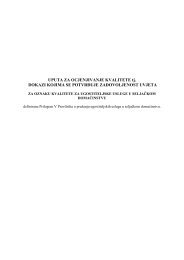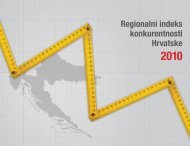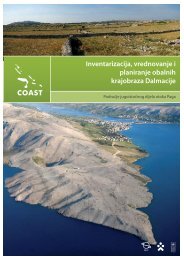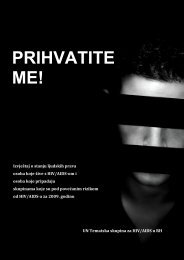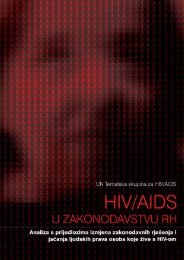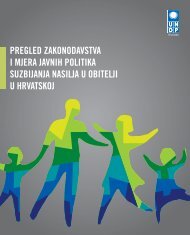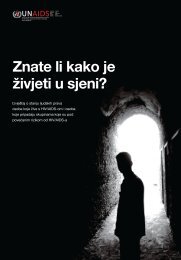THE SOCIALLY EXCLUDEDCHAPTER 3Box 18: Example of good practice - AssociationMoStOf the 268 users who have passed through theReception Centre in Split, 178 of them are reportedto have resolved their problems and improved theirsituation. Only every tenth person did not manageto do so, usually those with serious health problems.With the expert psychosocial assistance providedby the staff of the Association MoSt, 17 people havemanaged to return to their families, 55 have foundtemporary or permanent employment, and 23 nowreceive a pension which allows them to pay for anapartment. The Association has helped homelessindividuals find more permanent housing solutionssuch as apartments, restoration of houses, donatedtrailers, and accommodation in the homes for theelderly and infirmed. In addition to expert workers(social workers, special educators, psychologists), therole of volunteers and conscripts who have optedto do community service as part of their nationalservice is extremely important to the Association’ssuccess. The Association MoSt has raised awarenessamongst students about volunteerism, and eachyear they organise a humanitarian action “Andwhere are you?” with the purpose of sensitising thepublic to the problems of the homeless and othersocially vulnerable citizens.The Association also takes care of approximately 40individuals (former users of the Reception Centres)and their families, with food, clothing, and financialsupport. They have also engaged a lawyer to helpresolve court disputes in which users are involved.They plan to launch various re-socialisation andday stay programmes for the homeless and otherpeople who are at risk of social exclusion. Thesewould consist of various work-related activities asa form of re-socialisation, but also of self-financing(photocopying, book-binding, making of smallerobjects from plastic, serigraphy, T-shirt print, “secondhand shop” and the like).most all (92%) took advantage of soup kitchens on aregular basis. Most homeless people in Zagreb have amid-day meal at one of two soup kitchens of the Cityof Zagreb at Cerska and Branimirova, which prepareover 4,000 meals every day. In order to receive a mealin the soup kitchens, individuals require a referral slipfrom the CSW. Homeless people who do not have areferral slip, receive their meals in church soup kitchensat four locations.For the users of the Reception Centre for the Homelessin Split, the Town of Split funds a mid-day meal for<strong>Croatia</strong>n citizens in DES 146 soup kitchens (390 meals)if they cannot receive such support through the SplitSocial Welfare Centre. For those who do not have <strong>Croatia</strong>ncitizenship, food is provided by the soup kitchenof Caritas (120 meals) with help from the Parish of St.Dominic. Breakfast and dinner in the Reception Centreis organized by the Association MoSt with help fromprivate donations. In the Homeless Centre in Osijek,Caritas pays for breakfast and dinner, as well as lunch inthe soup kitchen (170 meals), and the Town Council cofinanceslunch for the elderly and the incapacitated.3.12.3 Access to HealthcareThe data gathered during the Zagreb survey of 2002indicates that 73% of the homeless realized their rightto health protection through the City Office for Health,Labour, Social Protection and Veterans. Others hadhealth protection through another mechanism (veteran’sstatus, pension, through spouse, etc.) while only asmall number of homeless people were without healthprotection. The City of Zagreb provides free medicalcheck-ups for the homeless, if needed, as an additionalprogramme activity. The first one was organised in2004, but despite good coverage the response wasbelow the expected, only about fifteen people.Individuals who become seriously ill in a countyother than the one in which they are registered asresidents, encounter significant problems accessingnecessary health services, which is a particular problemfor the homeless who are not registered in anycounty. In such a case, there is no secured coveragefor the costs of hospital treatment. In Split, the onlyoption is to use temporary health insurance, which isissued by the branch Department for Health Care andSocial Welfare in this county, but only if the person inquestion had already sent an application for the rightto social assistance to the Split Social Welfare Centre(for which it is necessary to have personal documents).146 DES – Institution for the employment, work and professional rehabilitation of persons with disabilities107
CHAPTER 3THE SOCIALLY EXCLUDEDIn June 2006, of the 21 people accommodated in theshelter, two-thirds had health insurance, and the samenumber received social assistance. As of 2002, the AssociationMoSt has been cooperating with a generalpractitioner in Split who performs preventive checkupsfor people who do not have health insurance.3.12.4 Access to EducationThe level of education of the homeless in Zagreb issomewhat lower than that of the general population. Inboth populations, the majority have completed secondaryschool, but for the general population this proportionis slightly over 50%, and in the case of the homelesspopulation it is approximately 37%. Every tenth homelessperson in Zagreb has no education at all. However,the low level of education is also confirmed by the factthat in both Split and Zagreb almost one fourth of thehomeless had not finished primary education.istered employment. A few users of homeless sheltersare able to find temporary low paying jobs, such ascleaning staircases and apartments, and manuallabour, which do not provide them with pension orhealth insurance, neither are they secure enough toenable them to plan their future outside the shelter.The Reception Centre for the Homeless in Split organisesre-socialisation programmes designed to helpthe homeless find useful public jobs. One such programmeincludes eight homeless people who cleanthe Youth Home several times a week and the publicbeach Bačvice over the summer, receiving remunerationfor their work.Figure 14: The Structure of the Unemployed in Zagreb,2002occasional jobs -registered16 %was imployed,left work12 %Figure13: Education level of the homeless in Zagreb,2002other14 %never employed21 %108incompleteprimaryschool16 %no school9 %primary school23 %university1 %post secondaryschool1 %other3 %secondaryschool35 %incompletesecondary school12 %3.12.5 Access to Employment andEmployment ServicesOver half of the homeless in Zagreb have beenunemployed for quite some time. Those who havenever worked are almost exclusively women. Morethan 20% of the homeless have disabilities, and 13%do not have the capacity to work. Some homelesspeople could acquire social benefits based on theiryears of service, as one-fifth have over 14 years of reg-was imployed,dismissed20 %3.12.6 Access to Transportationoccasional jobs -unregistered17 %In Split, the people who use the Reception Centre forthe Homeless have reported that it is problematic toget to the soup kitchen which is at quite a distancefrom the city centre. The cost of transportation is notsubsidized, and the price of monthly tickets is toohigh for the homeless to afford. They are only allowedstay in the soup kitchen for up to two hours, and soare forced to sp<strong>end</strong> the rest of the day in town parks,bus/train stations and other public places, until theevening hours when the kitchen re-opens.There is a special problem when homeless peoplehave children accommodated in the institutionsof social welfare in another county. For example, awoman from Split who participated in the focus grouphas two children under age, who live in the Home inOsijek. She is only able to see them rarely and thesevisits are funded by the Centre for Social Welfare.



